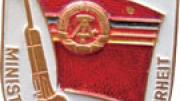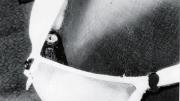A recording device hidden in an ashtray. A camera concealed inside a pen, an innocuous-looking deer statuette, or even a bra. A chair that captures your body scent when you sit on it, to facilitate tracking your movements later.
What sound like gadgets from a James Bond movie were real-life instruments of espionage used by the Stasi—communist East Germany’s Ministry for State Security (Staatssicherheit), the secret police. Kristie Macrakis, Ph.D. ’89, learned about these devices and much more in her exploration of the Stasi archives, which were gradually declassified and opened for public perusal starting in 1992, three years after the fall of the Berlin Wall.
Devices of Espionage
Macrakis wrote her dissertation on science in Nazi Germany, but a trip to conduct research in East Germany before the Wall fell blossomed into a fascination with the Cold War period and Stasi spying techniques. She spent eight years intermittently poking through thousands of files during short trips, summers, and a year-long Fulbright scholarship, focusing on two particular aspects of East German spy science: how the Stasi got access to top-secret intelligence and scientific knowledge from the West, and the spying techniques they used.
The resulting book, Seduced by Secrets: Inside the Stasi’s Spy-Tech World (Cambridge University Press), may make even post-Cold War readers suspicious of everyday objects. Consider the “smell chair,” whose seat covering was an interchangeable cloth fastened down to look like a regular cushion. After the “target” got up from the chair, Stasi agents would collect the cloth and store it in an airtight jar. The captured scent served as a kind of pheromonal fingerprint, a form of positive ID in an age of ever-multiplying code names and aliases. The Stasi used this method to check up on known dissidents and employees suspected of acting as double agents. If they could gain access to the hotel room or office where an allegedly duplicitous meeting took place, they could use dogs to determine whether their target had been there.
Macrakis didn’t just pore through documents. She viewed spying equipment in museums, criminal-evidence archives, and private collections. She learned about scent-detecting dogs from a dog trainer. She mixed up invisible ink using a recipe she found in the Stasi archives. And she interviewed two dozen former Stasi leaders, case officers, and agents, including Markus Wolf, who directed the Stasi’s foreign intelligence department for 34 years, and Werner Stiller, the defector who gave 20,000 pages of microfilmed documents to the West Germans. These experiences sometimes assumed all the intrigue of a John Le Carré novel. When Stiller invited her to stay overnight in the guest room of his home in Frankfurt, she jumped at the chance to spend time with such a crucial source. But the prospect of staying by herself in the home of a strange man who had stolen nuclear secrets from the West, then sold out his country and employer to the West, made her cautious enough to craft an escape plan that involved jumping out a window.
For the past year, Macrakis has been at Harvard as a visiting scholar in the history of science department. Her next project delves deeper into the topic of invisible ink; she has found a wealth of resources in Widener and Houghton libraries, including the earliest mention of invisible ink she has located: a text written in ancient Greek around 250 b.c. (She returns to Michigan State University, where she is a professor, this fall, and will move to a new job at the Georgia Institute of Technology in January.)
And she will be watching closely as the Stasi archives yield still more secrets. The German government regularly declassifies new files, and a massive effort is under way to reconstruct records shredded in 1989 as the East German regime dissolved. Yet review by scholars and journalists, even of the materials already available, has been far from comprehensive. Contrary to the popular impression—that the files were thrown open in 1992 and anyone may browse through the drawers—the commission that runs the archives strictly controls access; visitors must request specific files. Macrakis says she discovered the identities of Stasi agents and informants whose spying activities would, to her knowledge, be news to their current employers. Her book omits some people’s names and identifies others only by first name and last initial.
The East German Spies
Macrakis writes that the Stasi “became so caught up in the great game of espionage that it lost sight of its initial goals.” The agency devoted a large proportion of its resources to finding out who was working for the other side: developing one machine that could steam open 600 letters an hour and another that could reseal them twice as fast, and employing between 3,000 and 4,000 people in a department that focused on eavesdropping in hopes of catching someone in a subversive act or overhearing a conversation—with a mistress, perhaps—that could later be used for blackmail. (The resulting paranoia that characterized life in the German Democratic Republic is depicted in the 2007 Academy Award-winning film The Lives of Others.)
For all the effort expended, Macrakis concludes that in terms of surpassing the enemy in science and technology, Stasi spying was mostly futile; East Germany would have been wiser to invest in innovation. Particularly in fast-moving fields such as computers, engineering, and nuclear physics, she writes, “A scientific establishment based on pirated and cloned technology can never be a leader.”











